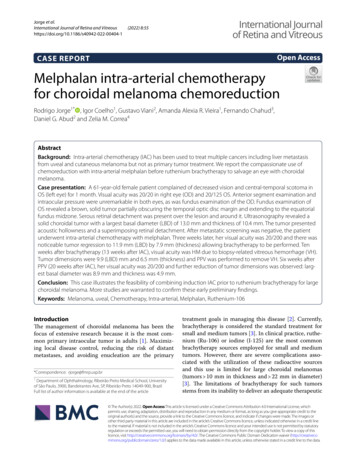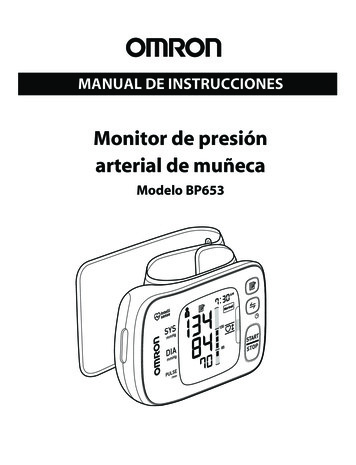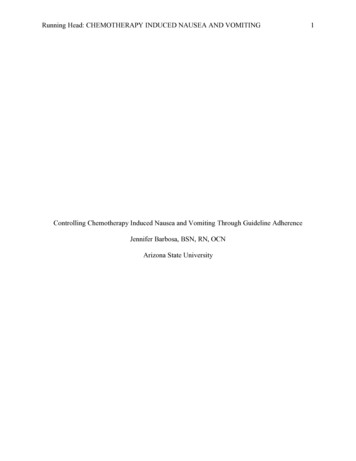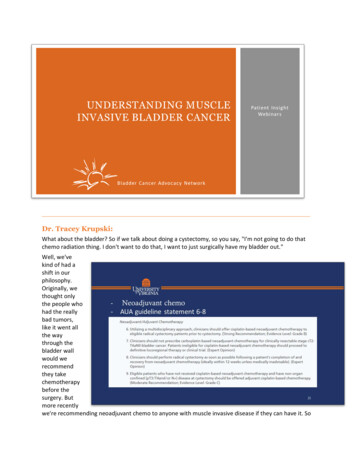
Transcription
Jorge et al.International Journal of Retina and (2022) 8:55International Journalof Retina and VitreousOpen AccessCASE REPORTMelphalan intra‑arterial chemotherapyfor choroidal melanoma chemoreductionRodrigo Jorge1* , Igor Coelho1, Gustavo Viani2, Amanda Alexia R. Vieira1, Fernando Chahud3,Daniel G. Abud2 and Zelia M. Correa4AbstractBackground: Intra-arterial chemotherapy (IAC) has been used to treat multiple cancers including liver metastasisfrom uveal and cutaneous melanoma but not as primary tumor treatment. We report the compassionate use ofchemoreduction with intra-arterial melphalan before ruthenium brachytherapy to salvage an eye with choroidalmelanoma.Case presentation: A 61-year-old female patient complained of decreased vision and central-temporal scotoma inOS (left eye) for 1 month. Visual acuity was 20/20 in right eye (OD) and 20/125 OS. Anterior segment examination andintraocular pressure were unremarkable in both eyes, as was fundus examination of the OD. Fundus examination ofOS revealed a brown, solid tumor partially obscuring the temporal optic disc margin and extending to the equatorialfundus midzone. Serous retinal detachment was present over the lesion and around it. Ultrasonography revealed asolid choroidal tumor with a largest basal diameter (LBD) of 13.0 mm and thickness of 10.4 mm. The tumor presentedacoustic hollowness and a superimposing retinal detachment. After metastatic screening was negative, the patientunderwent intra-arterial chemotherapy with melphalan. Three weeks later, her visual acuity was 20/200 and there wasnoticeable tumor regression to 11.9 mm (LBD) by 7.9 mm (thickness) allowing brachytherapy to be performed. Tenweeks after brachytherapy (13 weeks after IAC), visual acuity was HM due to biopsy-related vitreous hemorrhage (VH).Tumor dimensions were 9.9 (LBD) mm and 6.5 mm (thickness) and PPV was performed to remove VH. Six weeks afterPPV (20 weeks after IAC), her visual acuity was 20/200 and further reduction of tumor dimensions was observed: largest basal diameter was 8.9 mm and thickness was 4.9 mm.Conclusion: This case illustrates the feasibility of combining induction IAC prior to ruthenium brachytherapy for largechoroidal melanoma. More studies are warranted to confirm these early preliminary findings.Keywords: Melanoma, uveal, Chemotherapy, Intra-arterial, Melphalan, Ruthenium-106IntroductionThe management of choroidal melanoma has been thefocus of extensive research because it is the most common primary intraocular tumor in adults [1]. Maximizing local disease control, reducing the risk of distantmetastases, and avoiding enucleation are the primary*Correspondence: rjorge@fmrp.usp.br1Department of Ophthalmology, Ribeirão Preto Medical School, Universityof São Paulo, 3900, Bandeirantes Ave, SP, Ribeirão Preto 14049‑900, BrazilFull list of author information is available at the end of the articletreatment goals in managing this disease [2]. Currently,brachytherapy is considered the standard treatment forsmall and medium tumors [3]. In clinical practice, ruthenium (Ru-106) or iodine (I-125) are the most commonbrachytherapy sources employed for small and mediumtumors. However, there are severe complications associated with the utilization of these radioactive sourcesand this use is limited for large choroidal melanomas(tumors 10 mm in thickness and 22 mm in diameter)[3]. The limitations of brachytherapy for such tumorsstems from its inability to deliver an adequate therapeutic The Author(s) 2022. Open Access This article is licensed under a Creative Commons Attribution 4.0 International License, whichpermits use, sharing, adaptation, distribution and reproduction in any medium or format, as long as you give appropriate credit to theoriginal author(s) and the source, provide a link to the Creative Commons licence, and indicate if changes were made. The images orother third party material in this article are included in the article’s Creative Commons licence, unless indicated otherwise in a credit lineto the material. If material is not included in the article’s Creative Commons licence and your intended use is not permitted by statutoryregulation or exceeds the permitted use, you will need to obtain permission directly from the copyright holder. To view a copy of thislicence, visit http:// creat iveco mmons. org/ licen ses/ by/4. 0/. The Creative Commons Public Domain Dedication waiver (http:// creat iveco mmons. org/ publi cdoma in/ zero/1. 0/) applies to the data made available in this article, unless otherwise stated in a credit line to the data.
Jorge et al. International Journal of Retina and Vitreous(2022) 8:55dose due to the need to deliver high doses to the sclerathat translates into poor outcomes and severe complications. In this context, in the last decades, other treatmentoptions such as external beam radiotherapy (EBRT),radiosurgery (Gamma Knife or linear accelerator), andproton therapy has been investigated [4].Although gamma knife radiosurgery and proton therapy are effective treatments with reliable tumor controlrates, they are associated with poor visual outcomes,inadequate globe retention, and their use is reportedlylimited to the public health system of low- or middleincome countries [5, 6]. EBRT carries the risk of significant side effects related to a broader radiation field andincreased risk of complications ocular and periocularstructures such as eyelids, sclera, lens, and retina [7].Finally, enucleation is an effective management for verylarge tumors and usually a last resource.Considering the above-mentioned treatment limitations for large choroidal melanomas, our group exploredan alternative approach using intra-arterial with melphalan for choroidal melanoma chemoreduction to reducetumor thickness and allow subsequent brachytherapyusing Ru-106 plaque.Case reportA 61-year-old female patient, presented for an ocular oncology consultation complaining of reduced visual acuity and central-temporal scotoma for 1 monthin her left eye. Visual acuity was 20/20 in the right eye(OD) and 20/125 in left eye (OS). The anterior segmentand intraocular pressure were normal in both eyes, aswas fundus examination of the OD. Fundus examination of OS revealed a brownish-pigmented, elevatedlesion covering the optic nerve and extending to theequatorial region also nasally. There was serous retinaldetachment over the lesion and around it (Fig. 1A, B).The infrared image showed the shadow of the choroidaltumor obscuring part of the papillomacular bundle andthe temporal margin of the optic disc (Fig. 1C). Optical coherence tomography showed epiretinal membraneand possible tumor mechanically induced retinoschisis (Fig. 1D). On ultrasonography evaluation, the lesionpresented superimposing retinal detachment, acoustichollowness and had a basal diameter of 13.0 mm and anapical height of 10.4 mm leading to the diagnosis choroidal melanoma (Fig. 1B). Systemic screening was negativefor other primary tumors and metastasis. At this point,the patient was offered I-125 plaque (only available atother oncology centers, mainly private practice ones),external beam radiation therapy (EBRT), and enucleation. Since the patient could not afford I-125 brachytherapy, and declined EBRT due to its known side effects, weoffered an alternative compassionate use of intra-arterialPage 2 of 5chemoreduction with Melphalan followed by Ru-106plaque to avoid enucleation. After extensive discussionof all potential risks and benefits of these procedures,the patient opted to undergo intra-arterial chemotherapy(IAC) with 7.5 mg of Melphalan after selective catheterization of the ophthalmic artery under local anesthesia.Three weeks after Melphalan IAC, her visual acuity was20/200 and there was partial regression of the tumor andoverlying retinal detachment, as verified on color fundus photo (Fig. 1E) and optical coherence tomography(OCT) (Fig. 1H). On infrared reflectance image, therewas evident reduction of papillomacular bundle shadowing (Fig. 1G) and OCT showed discrete subfoveal fluidand regression of retinoschisis (Fig. 1H). On ultrasoundevaluation, the largest basal diameter (LBD) was 11.9 mmand thickness was 7.9 mm; cystic changes suggestive ofnecrosis were also noted. (Fig. 1F) Ru-106 brachytherapywas then performed using a 24-mm notched plaque. Dueto tumor thickness and previous IAC, the target dose tothe tumor apex was 65 Gy delivered over 82 h. Prior toplaque placement, fine needle aspiration biopsy was performed using binocular indirect ophthalmoscopy to sample the tumor and evaluate cellular viability after IAC.There was limited vitreous hemorrhage over the lesionimmediately after the biopsy. Cytology analysis revealedno viable melanocytes; there were only very rare lymphocytes and histiocytes. One week after surgery, thepatient presented visual acuity of 20/800 in OS. Therewas biopsy-related vitreous hemorrhage and an increaseof retinal detachment related to radiation treatment.Ten weeks after brachytherapy (13 weeks after IAC), hervisual acuity was HM and there was little clearance ofthe vitreous hemorrhage. On indirect ophthalmoscopy,only the optic nerve and a small portion of the superiorperipheral retina could be visualized. On ultrasoundevaluation, the LBD was 9.9 mm and thickness was6.5 mm. There was still an inferior retinal detachment,and the retina seemed more fixed than previous evaluations. Since the tumor thickness was approximately 4 mmsmaller (6.5 mm) compared to presentation, we assumedthat tumor control had been achieved and we discussedwith the patient the possibility of pars plana vitrectomy(PPV) for nonclearing vitreous hemorrhage and possible retinal reattachment during surgery. Patient agreedand three-port 23-gauge PPV was performed and vitreous hemorrhage was aspirated. During surgery, the retinal detachment seemed bullous and no tear was found.For this reason, the peroperative decision was to inject1.0 mg of triamcinolone acetonide into the vitreous cavity without any retinal manipulation. Six weeks after PPV(20 weeks after IAC), her visual acuity was 20/200 andfurther reduction of tumor dimensions was observed.The largest basal diameter was 8.9 mm and thickness
Jorge et al. International Journal of Retina and Vitreous(2022) 8:55Page 3 of 5Fig. 1 Multimodal assessment of tumor response to intra-arterial chemoreduction. A–D Baseline, immediately before IAC). Color fundus pictureof OS revealed a brownish-pigmented, elevated lesion covering the nasal margin of the optic nerve and extending to the equatorial region alsonasally. There was serous retinal detachment over the lesion and around it. B Ultrasonography picture showing an elevated choroidal lesionwith acoustic hollowness and a thickness of 10.4 mm (1:red line) and a LBD of 13 mm (2:yellow line); the lesion presented superimposing retinaldetachment. C Near-infrared reflectance image illustrating the shadow of the temporal margin of the choroidal tumor obscuring part of thepapillomacular bundle and the temporal margin of the optic disc. D Optical coherence tomography showed epiretinal membrane, retinoschisis,and discrete amount of subfoveal fluid. E–H: three weeks after IAC: E Color fundus photo shows partial tumor regression with overlying retinaldetachment (mainly inferiorly); F On Ultrasonography, choroidal tumor thickness was 7.9 mm (3:red line) and LBD was 11.9 mm (4:yellow line);cystic changes suggestive of necrosis were also verified (asterisk); G On infrared reflectance image, there was evident reduction of papillomacularbundle shadowing by the choroidal lesion and optical coherence tomography H showed a discrete increase on subfoveal fluid, with maintenanceof the remaining retinal architecture. I–L: 20 weeks after IAC): I Most of the optic nerve was now visible on color fundus picture. It also shows furthertumor size reduction, which is corroborated by ultrasound measurements (J): thickness: 4.9 mm (5:red line), LBD: 8.9 mm (6:yellow line). K Infraredreflectance demonstrated complete tumor regression in the papillomacular bundle. L OCT illustrates persistent discrete subretinal fluidwas 4.9 mm at the patient’s last follow-up 17 weeks afterRu-106 brachytherapy. There was still some subretinalfluid on OCT (Fig. 1I–L).DiscussionTo our knowledge and based on a thorough PUBMEDsearch, this is the first report of IAC using single agentmelphalan as a bridge therapy for choroidal melanomaprior to brachytherapy. The rationale for this exploratorytherapy comes from the experience of other authors thathave reported the use of IAC for uveal melanoma metastatic to the liver and cutaneous melanoma metastaticto the limb. Melphalan was first used as a regionalchemotherapeutic agent in 1957 [8] and was subsequently shown to be cytotoxic to melanoma cells in vitrousing human cell line (RPMI 8322) [9]. According toMinor et al., melphalan is particularly suited to regionalchemotherapy due to its short half-life, its low toxicityto the vascular endothelium and soft tissue and its relatively linear dose–response relationship with respect tocytotoxicity [10]. Besides melphalan, other drugs such ascarboplatin and topotecan may also be tried, but there isno evidence that melanoma cells would respond to thesedrugs.Systemic toxicity, mainly related to myelosuppression,heralds the systemic use of high doses of Melphalan. For
Jorge et al. International Journal of Retina and Vitreous(2022) 8:55this reason, several successful therapies, including treatment of cutaneous melanoma of the limbs, metastaticto the liver, and ocular tumors such as retinoblastomainvolve the regional use of this chemotherapeutical agent.Our patient did not present any systemic side effect.We performed a complete blood count with differential before and after IAC and there were no significantchanges. The lack of systemic toxicity we observed inthis case may be related to the low dose of 7.5 mg ofmelphalan used and the short follow-up. This particular dose of melphalan (7.5 mg) was used because it hasbeen reported to be safe in children with retinoblastoma. Despite the obvious difference in weight and bodysurface of our patient compared to children with retinoblastoma, tumor basal diameter and thickness werecomparable with retinoblastomas treated with IAC [11].Additionally, the dose of Melphalan used for 1 sessionof IAC offers lower risk of retinal toxicity [12] especiallywhen subsequent brachytherapy was planned. Finally,despite a residual retinal detachment, our patient didnot present significant signs of retinal toxicity thus far.In fact, the most remarkable finding was the increase ofvisual filed our patient experienced. She clearly reporteddecrease of central and temporal scotomas after IAC.This was probably related to tumor reduction (bothdiameter and thickness) and serous retinal detachmentdecrease (Fig. 1E–H). The tumor thickness reduced from10.4 mm at baseline to 7.9 mm 3 weeks after IAC, whenshe underwent ruthenium brachytherapy. After brachytherapy, there was further decline of tumor thickness to4.9 mm. (Fig. 1J).This exploratory treatment was only consideredbecause Ru-106 plaques (available through the Brazilianpublic health system) have limitations to tumor dimensions, especially thickness, the patient had no financialmeans to seek other alternative conservative therapies,and she declined EBRT and enucleation. In addition,one small portion of the tumor was over the optic nerveand ruthenium brachytherapy alone could not treat theentire lesion. Considering these circumstances and afterdetailed informed consent was obtained, the patientagreed to be treated with combination IAC and subsequent Ru-106 plaque that delivered 65 Gy to tumor apexduring a period of 82 h. The therapeutic dose chosen waslower than recommended by the Collaborative OcularMelanoma Study (85 Gy) to limit the scleral dose andmore serious ocular complications. This dose was alsobased on the equivalent total dose (50–70 Gy) reportedin studies utilizing proton beam therapy and stereotacticradiosurgery [2].This case showed that IAC with Melphalan could leadto a 20% reduction on choroidal melanoma thicknessPage 4 of 53 weeks after the procedure. Despite this importantreduction, the present report has limitations such asshort follow-up and lack of other toxicity evaluationssuch as ERG. One should bear in mind that this is anearly and preliminary report, and that the applicabilityof melphalan IAC chemoreduction needs to be furtherverified in larger series with longer follow-up.ConclusionThis case illustrates the feasibility of combining induction IAC prior to ruthenium brachytherapy for largechoroidal melanoma. Melphalan IAC could lead toa 20% reduction on choroidal melanoma thickness3 weeks after the procedure and subsequent brachytherapy was associated to additional 37% reduction (around 57% of total thickness reduction) after20 weeks of initial therapy.AcknowledgementsWe thank Dr. Murilo Rodrigues for helping with the high-resolution figure.Role of the sponsorsSponsors had no role in the design and conduct of the study; collection,management, analysis, and interpretation of the data; preparation, review,or approval of the manuscript; and decision to submit the manuscript forpublication. Rodrigo Jorge, M.D., PhD. had full access to all of data in the studyand takes responsibility for the integrity of the data and the accuracy of thedata analysis.Author contributionsRJ is the primary contributor to research design. IC, AA, FC, and DA are responsible for research execution and data acquisition. RJ, IC, GV, AA, FC, ZC, and DAare the primary contributors to data analysis and interpretation. Manuscriptpreparation by RJ, GV, DA, IC, AA with critical revisions provided by RJ, GV, DAand ZC. All authors read and approved the final manuscript.FundingThe authors received financial support from FAEPA (Fundação de Apoio aoEnsino, Pesquisa e Assistência do HCFMRP-USP) and from CNPq (ConselhoNacional de Desenvolvimento Científico e Tecnológico, grant 305299/2018.Dr. Correa i salso supported by an unrestricted grant from Research to Prevent Blindness (GR004596) to the Bascom Palmer Eye Institute.Availability of data and materialsData sharing is not applicable to this article as no datasets were generated oranalysed during the current study.DeclarationsEthics approval and consent to participateThe patient signed an informed consent before off label use of Melphalan IACfor Choroidal Melanoma was performed.Competing interestsNone related to the discussed topic.Author details1Department of Ophthalmology, Ribeirão Preto Medical School, Universityof São Paulo, 3900, Bandeirantes Ave, SP, Ribeirão Preto 14049‑900, Brazil.2Department of Medical Images, Hematology and Oncology, Ribeirão PretoMedical School, University of São Paulo, Ribeirão Preto, Brazil. 3 Departmentof Pathology, Ribeirão Preto Medical School, University of São Paulo, Ribeirão
Jorge et al. International Journal of Retina and Vitreous(2022) 8:55Page 5 of 5Preto, Brazil. 4 Ocular Oncology Service, Bascom Palmer Eye Institute, Universityof Miami, Miami, FL, USA.Received: 24 February 2022 Accepted: 5 August 2022References1. Krantz BA, Dave N, Komatsubara KM, Marr BP, Carvajal RD. Uveal melanoma: epidemiology, etiology, and treatment of primary disease. ClinOphthalmology. 2017. https:// doi. org/ 10. 2147/ OPTH. S89591.2. Singh M, Durairaj P, Yeung J. Uveal melanoma: a review of the literature.Oncol Ther. 2018;6(1):87–104. https:// doi. org/ 10. 1007/ s40487- 018- 0056-8.3. The American Brachytherapy Society—Ophthalmic Oncology Task Force.The American Brachytherapy Society consensus guidelines for plaquebrachytherapy of uveal melanoma and retinoblastoma. Brachytherapy.2014;13:1–14. https:// doi. org/ 10. 1016/j. brachy. 2013. 11. 008.4. Reichstein DA, Brock AL. Radiation therapy for uveal melanoma: a reviewof treatment methods available in 2021. Curr Opin Ophthalmol. 2021.https:// doi. org/ 10. 1097/ ICU. 00000 00000 000761.5. Parker T, Rigney G, Kallos J, Stefko ST, Kano H, Niranjan A, et al. Gammaknife radiosurgery for uveal melanomas and metastases: a systematicreview and meta-analysis. Lancet Oncol. 2020. https:// doi. org/ 10. 1016/ S1470- 2045(20) 30459-9.6. Marinkovic M, Pors LJ, van den Berg V, Peters FP, Schalenbourg A, Zografos L, Pica A, Hrbacek J, Van Duinen SG, Vu THK, Bleeker JC, Rasch CRN,Jager MJ, Luyten GPM, Horeweg N. Clinical outcomes after internationalreferral of uveal melanoma patients for proton therapy. Cancers (Basel).2021;13(24):6241. https:// doi. org/ 10. 3390/ cance rs132 46241.7. Thariat J, Martel A, Matet A, Loria O, Kodjikian L, Nguyen AM, Rosier L,Herault J, Nahon-Estève S, Mathis T. Non-cancer effects following ionizingirradiation involving the eye and orbit. Cancers (Basel). 2022;14(5):1194.https:// doi. org/ 10. 3390/ cance rs140 51194.8. Creech O, Krementz ET, Ryan RF, Winblad JN. Chemotherapy of cancer: regional perfusion utilizing an extracorporeal circuit. Ann Surg.1958;148:616–32. https:// doi. org/ 10. 1097/ 00000 658- 19581 0000- 00009.9. Hansson J, Lewensohn R, Ringborg U, Nilsson B. Formation and removalof DNA cross-links induced by melphalan and nitrogen mustard in relation to drug-induced cytotoxicity in human melanoma cells. Cancer Res.1987;47:2631–7.10. Minor DR, Allen RE, Alberts D, Peng YM, Tardelli G, Hutchinson J. A clinicaland pharmacokinetic study of isolated limb perfusion with heat and melphalan for melanoma. Cancer. 1985;55(11):2638–44. https:// doi. org/ 10. 1002/ 1097- 0142(19850 601) 55: 11% 3c263 8:: aid- cncr2 82055 1118% 3e3.0. co;2-e.11. Shields CL, Jorge R, Say EA, Magrath G, Alset A, Caywood E, et al. Unilateral retinoblastoma managed with intravenous chemotherapy versusintra-arterial chemotherapy. Outcomes based on the international classification of retinoblastoma. Asia Pac J Ophthalmol (Phila). 2016. https:// doi. org/ 10. 1097/ APO. 00000 00000 000172.12. Francis JH, Abramson DH, Gobin YP, Marr BP, Dunkel IJ, Riedel ER, BrodieSE. Electroretinogram monitoring of dose-dependent toxicity afterophthalmic artery chemosurgery in retinoblastoma eyes: six year review.PLoS ONE. 2014;9(1): e84247. https:// doi. org/ 10. 1371/ journ al. pone. 00842 47.Publisher’s NoteSpringer Nature remains neutral with regard to jurisdictional claims in published maps and institutional affiliations.Ready to submit your research ? Choose BMC and benefit from: fast, convenient online submission thorough peer review by experienced researchers in your field rapid publication on acceptance support for research data, including large and complex data types gold Open Access which fosters wider collaboration and increased citations maximum visibility for your research: over 100M website views per yearAt BMC, research is always in progress.Learn more biomedcentral.com/submissions
e management of choroidal melanoma has been the focus of extensive research because it is the most com-mon primary intraocular tumor in adults [-1]. Maximiz ing local disease control, reducing the risk of distant metastases, and avoiding enucleation are the primary treatment goals in managing this disease [2]. Currently,










